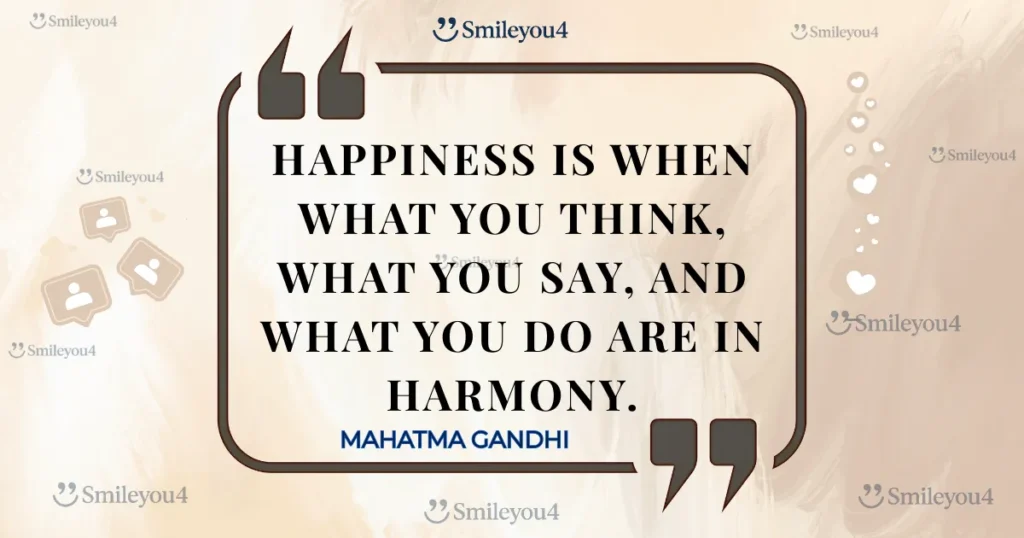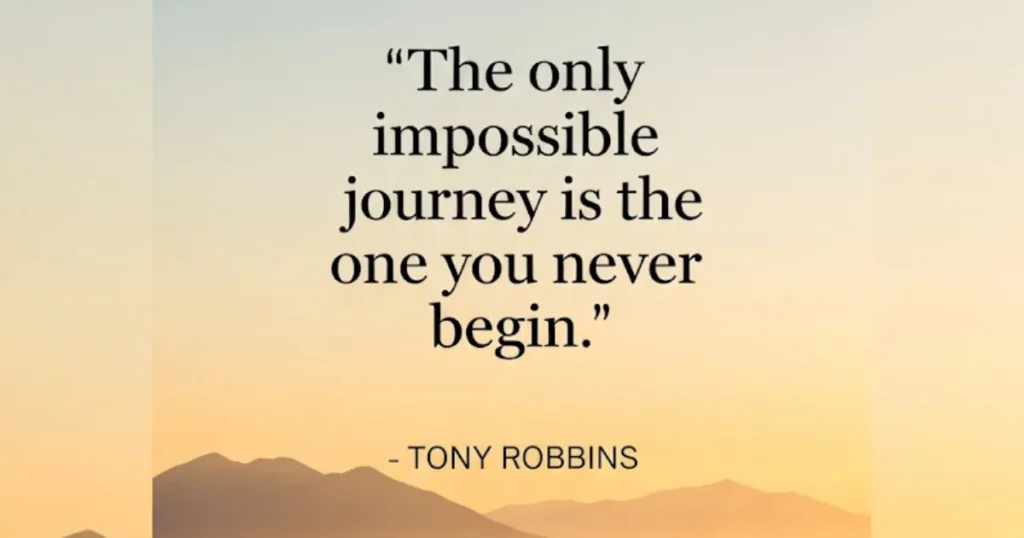What if the secret to lasting happiness isn’t found in achievements, possessions, or perfect circumstances—but in something far simpler yet more profound? Mahatma Gandhi understood this truth when he said, “Happiness is when what you think, what you say, and what you do are in harmony.” This happiness is harmony Mahatma Gandhi quote isn’t just beautiful philosophy—it’s a practical blueprint for creating genuine joy that starts from within.

You’ve probably experienced those moments when everything feels perfectly aligned. When your thoughts are clear, your words ring true, and your actions reflect your deepest values. In those precious moments, you taste what real contentment feels like. That’s because true happiness is harmony between these three fundamental aspects of your being.
Today, we’ll explore how this powerful principle can transform your daily life. You’ll discover why the Mahatma Gandhi quote about harmony holds the key to lasting fulfillment and learn actionable steps to bring your thoughts, words, and actions into beautiful alignment starting right now.
Understanding Gandhi’s Revolutionary Approach to Happiness
The Leader Who Lived His Truth
When Mahatma Gandhi declared that happiness is harmony, he spoke from extraordinary personal experience. As someone who led India’s independence movement through nonviolent resistance, Gandhi understood that authentic power comes from aligning your inner beliefs with your outer expressions.
Gandhi didn’t just preach this philosophy—he embodied it. His thoughts centered on justice and compassion, his words consistently promoted peace and equality, and his actions demonstrated unwavering commitment to his principles. Even under tremendous pressure, imprisonment, and personal sacrifice, he maintained inner peace because his life remained in harmony.
This Mahatma Gandhi quote happiness is harmony emerged from someone who discovered that external circumstances can’t destroy joy when your internal world remains aligned. His life proves that you can experience deep satisfaction even during challenging times when you maintain integrity between what you think, say, and do.
Breaking Down the Quote’s Life-Changing Elements
“Happiness is when what you think, what you say, and what you do are in harmony.” Let’s examine each component:
- “What you think” represents your beliefs, values, and inner dialogue
- “What you say” includes your words, promises, and communication with others
- “What you do” encompasses your actions, choices, and daily behaviors
This happiness is harmony principle works because it addresses the root cause of internal conflict. When these three elements align, you eliminate the stress and dissatisfaction that come from living a divided life.
The Science Behind Harmony and Happiness
How Alignment Affects Your Mental Health
Modern psychology confirms what Gandhi intuitively understood about the happiness is harmony connection. Research shows that people who maintain consistency between their values and actions experience significantly higher life satisfaction and lower rates of anxiety and depression.
Psychological benefits of harmony:
- Reduced cognitive dissonance and internal stress
- Increased self-respect and confidence
- Enhanced decision-making abilities
- Greater sense of purpose and meaning
- Improved relationships based on authenticity
Physical health advantages:
- Lower cortisol levels from reduced internal conflict
- Better sleep quality due to decreased mental tension
- Stronger immune system from authentic living
- Increased energy from eliminating exhausting pretense
This scientific backing proves that the Mahatma Gandhi quote about harmony isn’t just spiritual wisdom—it’s a practical strategy for optimal well-being.
The Cost of Living Out of Alignment
When your thoughts, words, and actions contradict each other, you create what psychologists call “cognitive dissonance.” This internal conflict literally drains your energy and undermines your happiness. Studies show that people living out of alignment experience:
- 60% higher stress levels than those living authentically
- Decreased satisfaction in relationships and work
- Reduced motivation for personal growth
- Increased susceptibility to anxiety and depression
- Lower self-esteem and confidence
Understanding these costs makes the happiness is harmony principle even more compelling—alignment isn’t just nice to have, it’s essential for mental health.
Real-Life Examples of Harmony Creating Happiness
Oprah Winfrey: Authenticity as Success Strategy
Oprah Winfrey perfectly embodies the happiness is harmony Mahatma Gandhi quote philosophy. Her extraordinary success comes from maintaining alignment between her thoughts, words, and actions across decades in the public eye.
Her harmony-based approach includes:
- Thoughts: Believing in human potential and the power of authentic storytelling
- Words: Speaking honestly about her struggles and consistently uplifting others
- Actions: Using her platform to educate, inspire, and create positive change
This alignment between her inner beliefs and outer expression created not just professional success, but deep personal satisfaction. Oprah demonstrates that happiness is harmony becomes a foundation for both achievement and fulfillment.
Nelson Mandela: Integrity Under Extreme Pressure
Nelson Mandela’s life offers a powerful example of how Mahatma Gandhi quote wisdom applies even under extreme circumstances. Despite 27 years in prison, Mandela maintained harmony between his commitment to justice, his words of reconciliation, and his actions toward peace.
His approach showed:
- Thoughts: Believing in equality and human dignity for all people
- Words: Speaking of reconciliation rather than revenge
- Actions: Leading South Africa toward unity instead of division
Mandela’s ability to maintain happiness is harmony during incredible hardship proves that alignment provides inner strength that external circumstances cannot destroy.
Steve Jobs: Passion Driving Innovation
Steve Jobs demonstrated the happiness is harmony principle through his relentless pursuit of products that reflected his vision of beautiful, functional technology. His alignment created both personal satisfaction and revolutionary innovations.
His harmony included:
- Thoughts: Believing technology should be intuitive and aesthetically pleasing
- Words: Communicating this vision clearly to teams and customers
- Actions: Refusing to compromise on quality despite pressure and criticism
Jobs showed that when you align your deepest convictions with your daily work, you create both personal fulfillment and extraordinary results.
Practical Steps to Achieve Harmony in Daily Life
Start with Self-Awareness: Know Your True Thoughts
Before you can create happiness is harmony, you need clarity about what you actually think and believe. Many people live on autopilot, never examining their true convictions.
Daily self-awareness practices:
- Spend 10 minutes each morning journaling about your authentic thoughts and feelings
- Question beliefs you’ve inherited from others—do they truly resonate with you?
- Notice when your energy increases or decreases during different activities
- Pay attention to what makes you feel proud versus what makes you feel drained
Weekly reflection questions:
- What values matter most to me right now?
- Which of my current beliefs serve my growth and happiness?
- Where do I notice conflict between what I think and how I live?
- What would I change if I were living more authentically?
Align Your Words with Your Values
The Mahatma Gandhi quote emphasizes that what you say must match what you think. This requires conscious attention to how you communicate with others and yourself.
Practical word-alignment strategies:
- Before speaking, ask yourself: “Does this reflect my true thoughts and values?”
- Practice saying “no” to requests that conflict with your priorities
- Express appreciation and gratitude regularly, matching your inner feelings
- Stop complaining about things you’re not willing to change
Communication improvements:
- Replace automatic responses with thoughtful replies
- Share your authentic opinions respectfully, even when they’re unpopular
- Make promises only when you genuinely intend to keep them
- Use “I” statements to express your truth without attacking others
Take Actions That Reflect Your Authentic Self
The final element of happiness is harmony involves ensuring your behaviors consistently express your deepest values and beliefs.
Action alignment techniques:
- Review your calendar—does it reflect your stated priorities?
- Evaluate your spending—do your purchases align with your values?
- Assess your relationships—do you behave authentically with the people in your life?
- Examine your work—does your job allow you to express your true self?
Daily behavior checks:
- Before making decisions, ask: “Will this action reflect who I truly am?”
- Choose activities that energize rather than drain your authentic self
- Set boundaries that protect your values and well-being
- Take small steps toward goals that genuinely matter to you
Overcoming Common Obstacles to Harmony
Moving Beyond People-Pleasing
Many people struggle with the happiness is harmony Mahatma Gandhi quote because they’ve spent years trying to please everyone else. Creating alignment requires prioritizing your authentic self over others’ expectations.
Strategies for authentic living:
- Remember that you can’t control others’ reactions to your authenticity
- Start with small acts of honesty and build your confidence gradually
- Surround yourself with people who appreciate your genuine self
- Practice self-compassion when others don’t understand your choices
Boundary-setting techniques:
- Learn to say “This doesn’t work for me” without extensive explanations
- Give yourself permission to change your mind as you grow
- Choose quality relationships over quantity of approval
- Remember that disappointing others is sometimes necessary for personal integrity
Dealing with Fear of Judgment
Living in harmony often requires making choices that others might not understand. The happiness is harmony principle becomes easier when you develop resilience against criticism.
Building confidence in authenticity:
- Focus on your own growth rather than others’ opinions
- Find role models who live authentically despite criticism
- Practice expressing your truth in low-stakes situations first
- Remember that judgment often reflects others’ insecurities, not your worth
Courage-building practices:
- Celebrate small acts of authenticity to build momentum
- Keep a journal of times when honesty led to positive outcomes
- Connect with communities that share your values
- Remember that Gandhi faced enormous criticism yet maintained his principles
Handling Internal Resistance
Sometimes the biggest obstacle to Mahatma Gandhi quote harmony is your own resistance to change. Old patterns feel comfortable even when they don’t serve you.
Working with internal resistance:
- Start with tiny changes to avoid overwhelming your system
- Practice self-compassion during the adjustment process
- Focus on how good alignment feels rather than forcing yourself
- Seek support from others who are also pursuing authentic living
Gradual alignment approach:
- Choose one area of your life to align first
- Make small daily choices that reflect your values
- Build on successes rather than trying to change everything at once
- Celebrate progress rather than demanding perfection
Building Your Personal Harmony Practice
Create Daily Alignment Rituals
Transform the happiness is harmony principle into daily practice through consistent rituals that keep you aligned:
Morning harmony check:
- Review your intentions for the day


